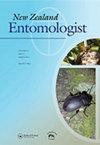Pore size requirements for mesh crop covers to protect potatoes from aphids
IF 0.4
4区 农林科学
Q4 ENTOMOLOGY
引用次数: 1
Abstract
ABSTRACT Crop covers made from polymer meshes have proved successful in protecting potatoes from tomato potato psyllid in New Zealand. However recent field trials indicated that aphids could penetrate these mesh covers resulting in high levels of aphid plant infestation. The current study used a laboratory assay to examine the mesh pore dimensions required to prevent penetration by apterous adults of two species of aphids commonly found on potatoes. Of the 22 commercial meshes tested, Myzus persicae managed to pass through 20 and Aphis gossypii managed to pass through 21. Logistic regression analysis indicated that the maximum allowable pore dimensions to exclude (99% of) aphids were approximately 0.06 mm in length, 0.15 mm diagonal and an area of 0.012 mm2. None of the meshes tested met any of these criteria, and if crop covers are to be used to protect crops from both TPP and aphids then meshes with smaller pore sizes would be required.保护马铃薯免受蚜虫侵害的网眼作物覆盖物的孔径要求
在新西兰,由聚合物网制成的作物覆盖物已被证明成功地保护了马铃薯免受番茄木虱的侵害。然而,最近的田间试验表明,蚜虫可以穿透这些网状覆盖物,导致蚜虫植物大量侵扰。目前的研究使用了一种实验室分析方法来检查防止马铃薯上常见的两种蚜虫的无翅成虫渗透所需的网状孔尺寸。在测试的22个商业网中,桃蚜成功通过20个,棉蚜成功通过21个。Logistic回归分析表明,可排除(99%)蚜虫的最大孔长约为0.06 mm,对角线约为0.15 mm,面积约为0.012 mm2。所有测试的网孔都不符合这些标准,如果作物覆盖被用来保护作物免受TPP和蚜虫的侵害,那么就需要孔径较小的网孔。
本文章由计算机程序翻译,如有差异,请以英文原文为准。
求助全文
约1分钟内获得全文
求助全文
来源期刊

New Zealand Entomologist
ENTOMOLOGY-
CiteScore
0.70
自引率
33.30%
发文量
3
审稿时长
>12 weeks
期刊介绍:
The invertebrate diversity of New Zealand is of great interest worldwide because of its geographic isolation and geological history. The New Zealand Entomologist plays an important role in disseminating information on field-based, experimental, and theoretical research.
The New Zealand Entomologist publishes original research papers, review papers and short communications. We welcome submissions in all aspects of science regarding insects and arthropods in a New Zealand or Australasian setting. The journal’s subject matter encompasses taxonomy, phylogenetics, biogeography, biological control and pest management, conservation, ecology and natural history.
The journal is the official publication of the Entomological Society of New Zealand. Papers published or submitted elsewhere for publication will not be considered, but publication of an abstract or summary elsewhere (e.g. conference proceedings) does not preclude full publication in the New Zealand Entomologist. Accepted papers become copyright of the Entomological Society of New Zealand. The journal is published in English, but we also welcome publication of abstracts in Maori.
 求助内容:
求助内容: 应助结果提醒方式:
应助结果提醒方式:


